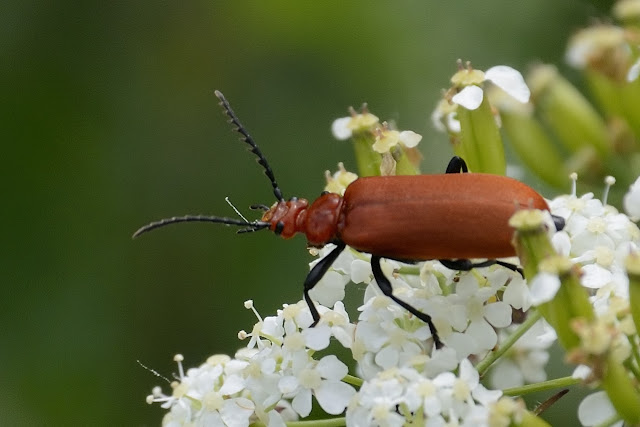Bugs galore - nature's little wonders
The end of May and beginning of June are great times to see some of the many insects that we have and which are still in good numbers. These images are all taken near home again, and highlight a small but stunning world, most of us are almost unaware of in our busy lives!
This little chap is the red-headed or 'common' cardinal beetle (Pyrochroa serraticornis). It is a red to orange beetle with, as the name suggests, a red head. It is about 20 millimetres (0.79 in) long, and is found throughout Britain
A scarce chaser (Libellula fulva) is a species of dragonfly. This one I believe is either a juvenile or a female. The adult male has a bright blue abdomen with patches of black, while the adult female and juvenile male each have a bright orange abdomen. It is about 45 mm in length with an average wingspan of 74 mm. This dragonfly is considered a species of special concern in Great Britain due to loss of its specific ideal habitat.
Banded Demoiselle
The Bloody-nosed beetle is a large, round, flightless beetle with long legs that can often be seen plodding across paths or through grass. It can be found during the spring and summer in grassland, heathland and along hedgerows. One of our largest 'leaf beetles', adults feed on the leaves of Lady's Bedstraw and related plants, and the larvae can be seen hanging from these species. Adults are mostly active at night. The strange name of the Bloody-nosed beetle derives from its unusual defence mechanism: when threatened, it secretes a distasteful blood-red liquid from its mouth.
The soldier beetles (Cantharidae) are relatively soft-bodied, straight-sided beetles. One of the first described species has a color pattern reminiscent of the red coats of early British soldiers, hence the common name which has stuck.
Female Stag Beetle (Lucanus cervus)
Stag beetles are one of our most spectacular insects. The male’s large jaws look just like the antlers of a stag. They spend most of their life underground as larvae, only emerging for a few weeks in the summer to find a mate and reproduce. Stag beetles and their larvae are quite harmless and are a joy to watch. Males are often seen flying around at dusk searching for a mate. They will wrestle or fight other males using their enlarged antler-like jaws. Although they can fly, female beetles are most often seen walking around on the ground. Once they’ve mated, females return to the spot where they emerged, if there is enough rotting wood to feed their young, and dig down into the soil to lay their small, round eggs in rotting wood such as log piles, tree stumps and old fence posts.
The most obvious problem for stag beetles is a significant loss of habitat. For example, many of London’s surviving open spaces have sadly been developed, including many woodlands. Development will continue to reduce stag beetle habitats, but increased awareness of their existence can help defend the beetles against development.
In addition the tidying of woodlands, parks and gardens has led to the removal of dead or decaying wood habitats which is the stag beetle larvae’s food source. Tree surgery operations such as stump-grinding of felled trees removes a vital habitat for the beetle. Although tidying up still continues in gardens, woodlands and park managers are now much more aware of the need to retain dead and decaying wood as part of the woodland ecosystem.
Humans are, unfortunately, a direct threat to stag beetles. Adult beetles are attracted to the warm surfaces of tarmac and pavements, which makes them particularly vulnerable to being crushed by traffic or feet. Stag beetles have a fearsome appearance and sometimes people kill them because they look ‘dangerous’.
And last, but not least, a Meadow Brown











Comments